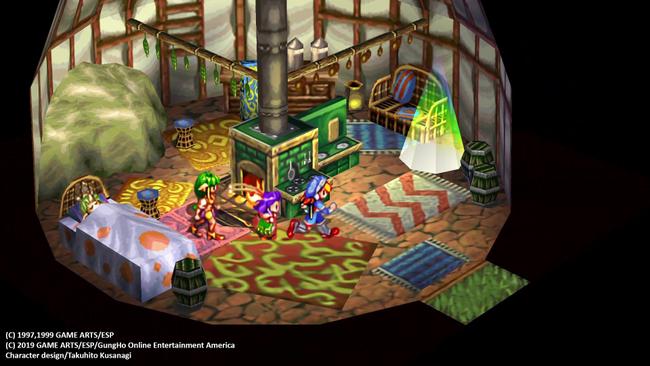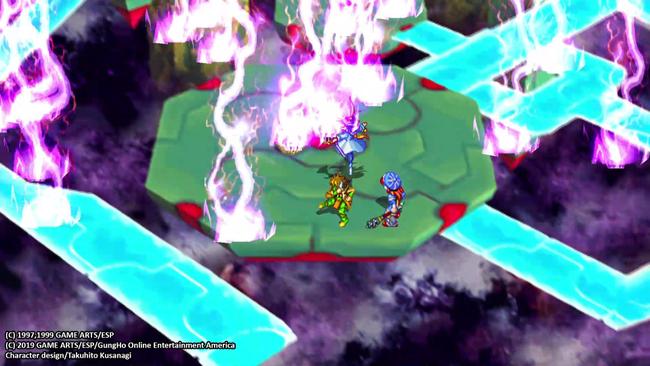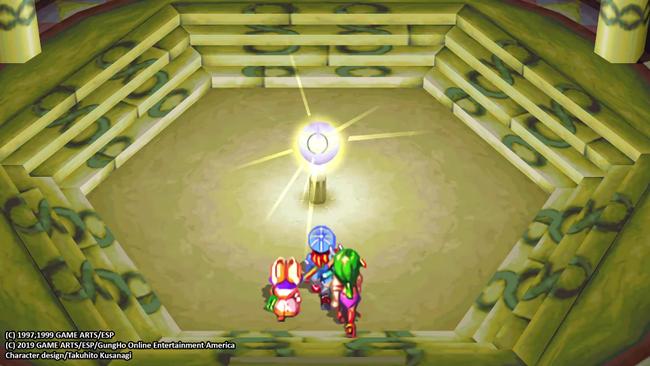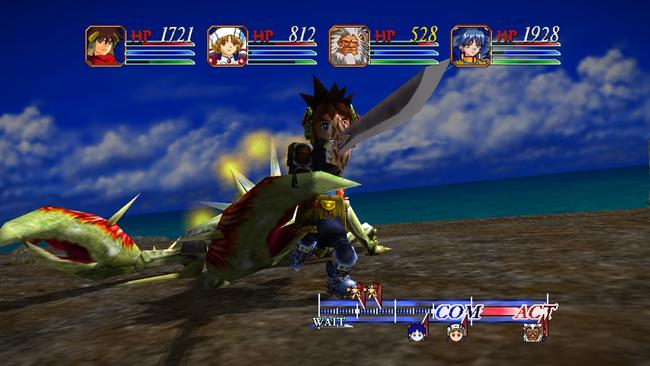
Grandia HD Collection Review
Despite the company having gone rather dormant in recent years, you’d be hard-pressed to find any RPG enthusiast who isn’t aware of Game Arts’ legacy. I think it’s fair to say that the Lunar series is what put the company on the map, but many will agree that it was the Grandia series that people remember the most. The first two games are beloved classics, and GungHo Online Entertainment has collaborated with SickHead Games to remaster both of them for the Grandia HD Collection.
GungHo promised HD resolutions, new widescreen support, and dual audio versions of both games, building off the work done in the previously released Grandia II Anniversary Edition PC port, and remastering the original Grandia for the first time ever. However, fans were worried about the state of Grandia’s remaster based on first impressions of the earlier PAX and E3 builds of the game. It seems like the team decided to filter every sprite and texture through a smoothing filter with no option to disable it. Unfortunately, this is still the case in the final version, leaving the title of “Grandia HD Collection” only half-accurate. It should be recognized that regardless of any quirks this collection has, at the end of the day these are both outstanding RPGs.
Before we get into how the remasters were handled, it’s important to establish what these games are even about for any newcomers out there.

Grandia is a tale of adventure, where a young troublemaker named Justin embarks on a journey with his childhood friend Sue to uncover the secrets of a lost civilization. It’s a simple story, but the execution is where it shines. The localization flows surprisingly well for a game released in 1999, adding to the story’s undeniable charm. The English voice acting leaves a lot to be desired, even for 90s standards, so I’m thankful for the option to switch to Japanese voices this time around. Few RPGs today have half the energy of Grandia; you’re constantly seeing new and interesting sights. The battle system matches that same energy, with an evolution on the active time battle system that adds a chaotic and lively spin to it. As cliché as it is to say, this game makes you feel like you’re going on an actual adventure. It’s exhilarating, to say the least.
Grandia II mixes things up quite a bit, but it works better than I expected it to. If the first game had an optimistic tone, this one could be better described as cynical. Edgy, even. Our protagonist is Ryudo, a rude mercenary called a “Geohound”. He takes a job one day to escort a church songtress named Elena to a mysterious ritual. As you can guess, things go horribly wrong, and Ryudo is tasked with escorting her on her new adventure. For a price, of course. He’s quite unbearable, but that’s sort of the point. Ryudo’s travels slowly make him grow as a person, and we might take for granted that making an RPG protagonist this unlikable was rare 19 years ago. From a gameplay perspective, it improves on just about everything from the original. The English voices here are certainly an improvement on this original, though Japanee voices are also available, too.

The remastering job isn’t without its merits, but I couldn’t help but feel that most of it was a bit of a mixed bag. Grandia II, with polygonal character models, made the transition well, but Grandia struggled in quite a few areas. How big of a deal to you the changes made are vary depending on personal preference, but it’s worth pointing them out.
While Grandia originally launched in Japan on the Sega Saturn, it was ported to PlayStation two years later, which was ultimately the version the west received. The PlayStation version it is often considered to be the inferior version, despite some improved spell effects and added content. Framerate was a big reason, as it feels noticeably slower in comparison to the original. When this new remaster was announced, fans were worried it was going to be based on the PlayStation version. Which it is… kind of.
SickHead Games used the PlayStation code base, but aimed to improve the game performance to be more comparable to the Saturn release. In my eyes, this was a big success. Everything from exploration to battles run smooth, without any framerate drops. Battles no longer feel as slow as they did on PS1, but it still would have been nice if a turbo option had been included. One strange new quirk to come from this remaster is the screen flashing at the beginning of every battle transition. Hopefully, this is addressed in a patch.

Combat plays out very similarly in both games. There are no random encounters, enemies icons will instead appear on the map. Grandia's battle system was especially distinct at the time of its release, so much so that it has become somewhat of a stylistic reference point for describing combat systems with a similar structure. The pace is set by the action bar on the bottom, with a character or enemies speed stat determining how long they must wait to perform another action. When any party member reaches the action stage of the bar, they get to act. The main way of attacking is “Combo” or “Critical”. Combo means two simple and quick physical attacks, whereas Critical is one slower attack that is used mainly to cancel enemy skills.
Every character also has a variety of special skills and magic. These are the most effective abilities in battle, but take a while to charge up and can leave you open to being canceled. You can also use items, block, and prep to evade. The trick to this is that any attack that lands on an enemy or party member will either freeze their progress or shoot them back on the action bar.
Let’s address the elephant in the room: the filtering on the visuals. Many releases of sprite-based games offer an optional toggle in a menu (for example, Disgaea PC), but that’s not the case here. It appears the smoothing filter wasn’t done in-engine, but applied to all the assets before they were added. It tends to make things look a tad blurry, and hardly HD. It can be jarring to see such crisp 3D models in the environment have blurry textures. I eventually got used to it, but I can see how it might be a deal-breaker for many.

The ideal way to handle this would have been to redraw everything or simply make the filter an option. Lunar Silver Star Harmony did the former to great results, but I understand how expensive that can be. Thankfully, the sprites being so high quality, to begin with, make the filtering look better than most ports in recent years to do this.
The visual touch-ups aren’t all iffy. The widescreen works very well, with only a handful of moments where the positioning of the sprites didn’t match up with the new ends of the screen. I appreciate the effort put into this, it allows all the sprites and environments to keep their aspect ratio. The fonts used in the PS1 version were recreated faithfully, I appreciated the attention to detail. The menus and UI were also perfectly recreated, they still look charming and very 90’s (especially with the Grandia logos populating the pause menu). Grandia’s anime cutscenes weren’t remade, but they were cleaned up as best as possible. The subtitles were implemented rather strangely, however, with all the subtitle text being framed by jarring black boxes.
Grandia II seems largely untouched from the PC version besides the new aspect ratio. The portraits and font are the exact same and didn’t receive the touch-ups the first game got, but they also needed them far less. The textures and 3D models look great in HD. The 3D presentation might not have aged as well as 2D sprites used in the original Grandia, but these Dreamcast era visuals still hold up. It’s easily the better-looking game in the collection, and overall a very solid conversion.

It didn’t come over completely unscathed though. There’s a strange glitch I found that happens sometimes when I’d turn the Switch back on from sleep mode, where the framerate would dip hard in all subsequent battles. This could be easily fixed by a console reset, but it was certainly frustrating to deal with every time it popped up. Lastly, and this is a bit of a nitpick, the camera starts inverted and would reset to that option every time I booted the game up.
I played Grandia I with the Japanese voice track and Grandia II with the English one. In both cases, I never had any moments where audio glitched, which was one of the problems with the E3 build. Grandia even supports the ability to switch the voice track in the actual game itself, without any reset needed. There was a minor problem I noticed on the soundtrack side of things, but just for the first game. The music can sometimes cut out for half a second, which makes me believe it’s a glitch in the music looping. It’s not a huge deal, but it happened often enough for me to have noticed.
As said before, I can’t stress enough just how wonderful both of these games are. Even with the issues I mentioned, I still had a great time playing through these two classics. These are thrilling tales of adventure with witty writing, charming characters, and plots that will constantly surprise you. The gameplay is fun, but simple at the same time. There’s never a dull moment with these two games, and they’re beloved for just that reason.
It says so much about the quality of these first two Grandia games, where I’m able to acknowledge all the flaws of this release but still come off it feeling positive. I hope GungHo supports the collection after launch with patches to polish things up, but even in its current state, I find this to be a solid Remaster.